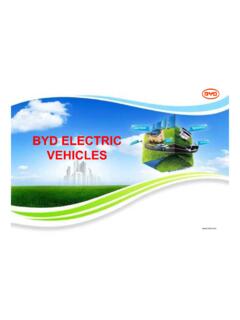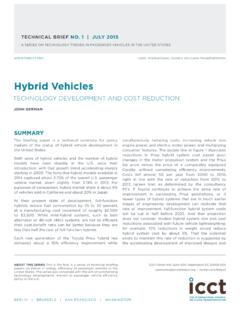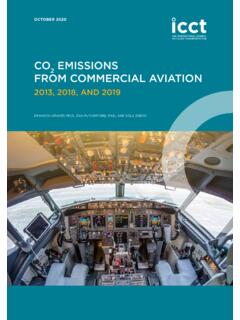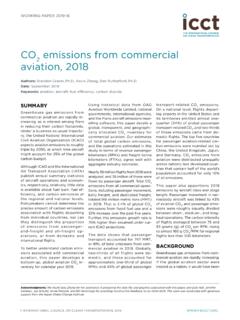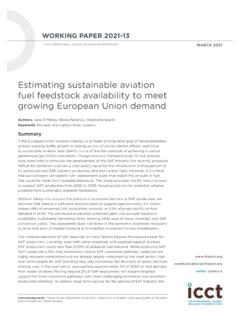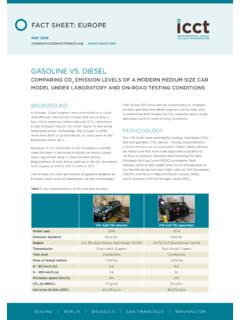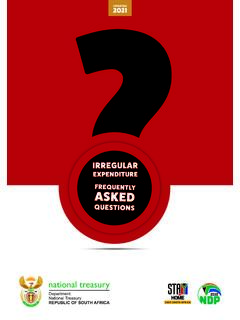Transcription of Fit for 55: A review and evaluation of the European ...
1 Fit for 55: A review and evaluation of the European Commission proposal for amending the CO2 targets for new cars and vansPrepared by Jan Dornoff, Peter Mock, Chelsea Baldino, Georg Bieker, Sonsoles D az, Josh Miller, Arijit Sen, Uwe Tietge, and Sandra WappelhorstBACKGROUNDOn July 14, the European Commission (EC) put forward Fit for 55, a package of regulatory proposals intended to secure a European Union (EU) economy-wide greenhouse gas (GHG) reduction of at least 55% by 2030, compared to 1990 These emission reduction efforts for 2030 are a follow-up of the European Green Deal,2 a sustainable growth strategy put forth in December 2019, and a response to the European Climate Law that foresees a legally binding target of climate neutrality by of the regulatory proposals adopted by the EC is to amend the mandatory carbon dioxide (CO2) emission targets for new passenger cars and light commercial vehicles (vans).
2 This briefing summarizes and evaluates the key elements of this proposal before it enters the political negotiation process between the European Parliament and the Regulation (EU) 2021/119 of the European Parliament and of the Council of 30 June 2021 establishing the framework for achieving climate neutrality and amending Regulations (EC) No 401/2009 and (EU) 2018/1999 ( European Climate Law ), European Commission, The European Green Deal: Communication from the Commission to the European Parliament, the European Council, the Council, the European Economic and Social Committee and the Committee of the Regions, (December 11, 2019).
3 B828d165- 3 European Commission, European Climate Law, (March 4, 2020), European Commission, Proposal for a regulation of the European Parliament and of the Council amending Regulation (EU) 2019/631 as regards strengthening the CO2 emission performance standards for new passenger cars and new light commercial vehicles in line with the Union s increased climate ambition, COM(2021) 556 final, 2021/0197 (COD), (July 14, 2021), 2021 INTERNATIONAL COUNCIL ON CLEAN TRANSPORTATIONBEIJING | BERLIN | SAN FRANCISCO | S O PAULO | WASHINGTONSEPTEMBER twitter @theicct2 ICCT BRIEFING | FIT FOR 55: A review AND evaluation OF THE European COMMISSION PROPOSALSUMMARY OF KEY ELEMENTS OF THE PROPOSALThe EC proposal strengthens the current 2030 CO2 targets, from to -55% for new passenger cars and from -31% to -50% for new vans, both relative to a 2021 baseline.
4 In addition, the proposal introduces a new 2035 CO2 target set at -100% for new cars and vans, again relative to a 2021 baseline. The 2025 CO2 target remains unchanged at -15% for both new cars and vans. The EC does not propose any interim targets nor a transition to annual instead of stepwise target values. Target values remain dependent on the average mass of a manufacturer s new vehicle fleet, for heavier vehicles, higher absolute CO2 emission levels are granted. The penalty for non-compliance with the CO2 targets remains unchanged, at a level of 95 per vehicle and per gram/km of benchmark target for zero- and low-emission vehicles (ZLEVs) for the years 2025 to 2029 remains in place, at a level of 15% of the respective fleets of new passenger cars and vans.
5 A manufacturer selling more ZLEVs can benefit from a relaxation of its CO2 target of up to 5%. Meanwhile, the previously enacted ZLEV benchmarks of 35% (cars) and 30% (vans) for 2030 are no longer part of the regulatory proposal as ZLEV credits are phased out from 2030 onwards. Plug-in hybrid electric vehicles (PHEVs) with official CO2 emission levels of less than 50 g/km continue to benefit from an extra discount factor for the purpose of the ZLEV credit calculations, artificially reducing the often already unrealistically low CO2 level of those vehicles by another 30%.
6 New registrations of ZLEVs in EU Member States with a fleetwide share of zero- and low-emission vehicles of below 60% of the Union average in 2017 and with less than 1,000 new ZLEVs registered in the same year continue to count times as much as those registrations in all other EU Member States, but only as long as less than 5% ZLEVs are registered in the member state for eco-innovation technologies remain in place, capped at a level of 7 gCO2/km, with the EC being empowered to adjust the cap from 2025 onwards.
7 Small manufacturers, with less than 10,000 new car and 22,000 new van registrations per year can still benefit from derogations but only until 2028. Also, an exemption for manufacturers with less than 1,000 registrations per year remains in provisions regarding real-world driving emission and energy consumption levels remain unchanged. This means the EC will continue to collect data from on-board fuel consumption and energy consumption monitors (OBFCMs). The data will be published for the first time at the end of 2022, aggregated by manufacturer, fuel type, vehicle category, and powertrain type.
8 By June 2023, the EC will assess how fuel and energy consumption data may be used to ensure that type-approval vehicle CO2 emissions and fuel or energy consumption values are representative of real-world emissions over time for each manufacturer and, in 2027, will assess the feasibility of adjusting a manufacturer s average specific emissions of CO2 as of vehicle CO2 regulation remains targeted at tailpipe emissions, leaving the reduction of upstream well-to-tank emissions, including those of non-CO2 greenhouse gases such as methane, to be dealt with by other regulations.
9 Consequently, the regulatory proposal does not provide for any credits for low-carbon fuels and leaves the promotion of renewable fuels for the Renewable Energy Directive and other December 2025, and every two years thereafter, the EC will report on the progress towards zero emission road mobility and assess the need for additional measures. In 2028, the EC will review the effectiveness and impact of the regulation and will eventually propose an part of the Fit for 55 package, the new vehicle CO2 targets regulation is accompanied by other regulations for establishing a separate emissions trading 3 ICCT BRIEFING | FIT FOR 55.
10 A review AND evaluation OF THE European COMMISSION PROPOSAL system (ETS) for the transport and buildings sectors, strengthening the recharging and refueling infrastructure, as well as adapting the energy tax levels across the EU. A regulatory proposal to amend the CO2 standards for new heavy-duty vehicles will follow in OF KEY ELEMENTS OF THE PROPOSALLEVEL AND TIMING OF EMISSIONS TARGETSThe proposed regulation would be the fourth set of mandatory vehicle CO2 performance standards in the EU. The first regulations for passenger cars (EC) 443/2009 and light commercial vehicles (EU) 510/2011, adopted in 2009 and 2011, respectively, after a voluntary commitment by the auto industry to reduce average vehicle CO2 emissions failed to produce adequate results, established EU fleet-wide targets of 130 g/km for new passenger cars in 2015 and 175 g/km for vans in 2017.
